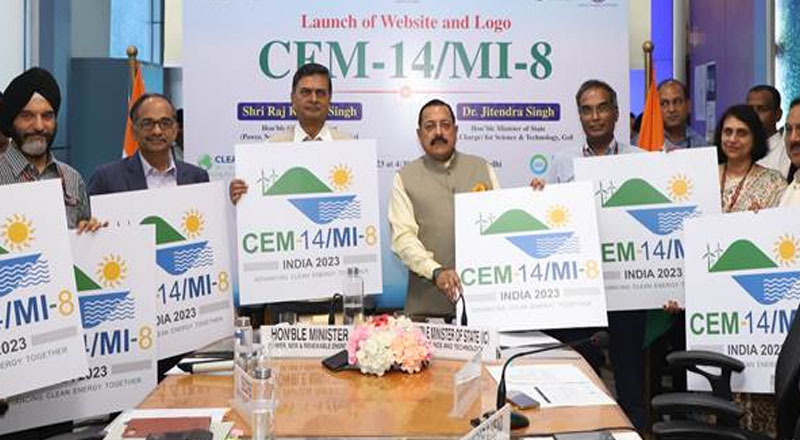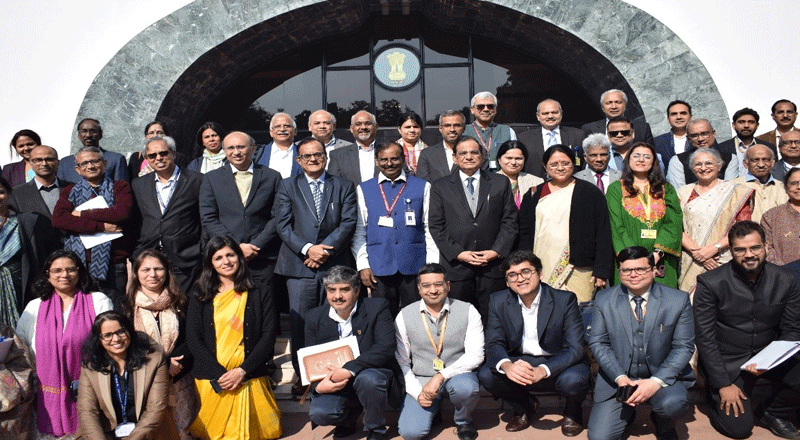The 14th Clean Energy Ministerial and 8th Mission Innovation meeting (CEM14/MI-8) will be held in Goa during 19th to 22nd of July, 2023. Scheduled on the margins of the G20 Energy Transitions Ministerial Meeting, the theme for CEM-14 / MI-8 is “Advancing Clean Energy Together”. This year’s Clean Energy Ministerial (CEM) and Mission Innovation (MI) meetings will bring together governments, international organizations, private sector, academia, innovators, civil society, early career researchers and policymakers over a four-day program featuring high-level ministerial dialogues, global initiative launches, award announcements, minister-CEO roundtables and a wide array of side-events cutting across diverse themes of clean energy transition. CEM14 / MI8 will also feature a public-facing technology showcase demonstrating cutting-edge advances in clean energy from India and around the world. The Ministerial plenaries are scheduled for July 21, 2023, while back-to-back G20 Energy Transition Ministerial Meeting will be held on July 22.
Under the theme of ” Advancing Clean Energy Together”, high-level roundtables, side-events and technology showcases would enable stakeholders to accelerate the deployment of clean energy by encouraging development of policies and programmes which advance clean energy technology and solutions around the world.
At an event held in the Power Ministry in New Delhi yesterday, the Union Power and New & Renewable Energy Minister R. K. Singh and Union Science & Technology Minister Dr. Jitendra Singh together launched the website and logo for the 14th Clean Energy Ministerial and 8th Mission lnnovation meetings. The website can be accessed here: https://www.cem-mi-india.org/. The website provides information on delegate registration, program overview, speakers’ details, participant and member portals and more.
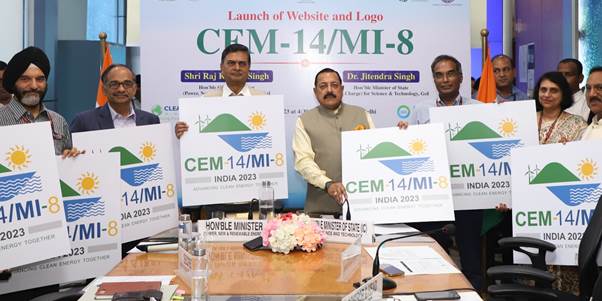
Following past ministerial tradition, a separate logo has been designed by the Government of lndia, as host of CEM14/Ml-8, for creating a unique identity for this high-level event.
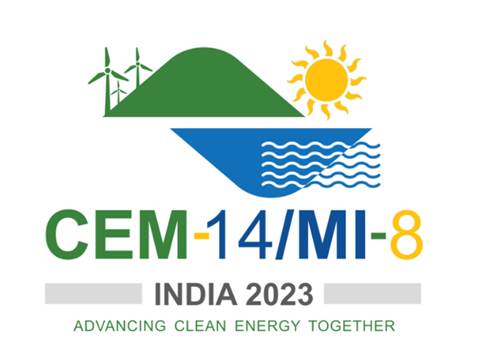
The logo (given above) depicts a diverse set of colours, representing the diversity of engagement among countries and partners. Renewable resources, such as sun, wind and water are highlighted. The crest and trough using green and blue, indicate the variability of renewable energy resources and the blend emphasises the first fuel of energy efficiency, which cuts across all aspects of energy use.
Launching the website and logo, the Power Minister said: “The Clean Energy Ministerial forum provides an opportunity to the country to convene the global clean energy community and engage on a diverse set of events and bring across the wide spectrum of clean energy innovation to deployment.”
The Power and New & Renewable Energy Minister said that India is adding renewable energy capacity at one of the fastest rates in the world and that this growth is continuing to happen despite disruptions due to the COVID-19 pandemic. India is making significant progress in reducing emission intensity as well, said the Minister. “India has emerged as a leader in energy transition and aim to continue to be a leader in climate action.”
The Minister said that the Clean Energy Ministerial will provide a forum to discuss issues such as adoption of green hydrogen towards Net Zero, formulation of common standards for international trade in green hydrogen and the concept of the whole world going green. “We need to make sure that the trade is free and open, we can’t have protectionism if we want the whole world to go green, and the whole world will have to go green, since one or two countries alone going green will not make a difference.”
Speaking about Mission Innovation meeting, the Minister said that the whole exercise of shifting towards a non-fossil fuel world is Mission Innovation. “The energy transition requires innovation across a number of fields; innovation is required for green steel, green fertilizers, green aluminium, green electricity, green feed stock and round-the-clock renewable energy. Innovation is tied up with our transition to a new world which is climate-friendly and planet-friendly.” The Minister said that mankind has to work together to address these challenges, explore alternatives such as sodium ion which can also help in diversified supply chains and formulate strategies for humankind.
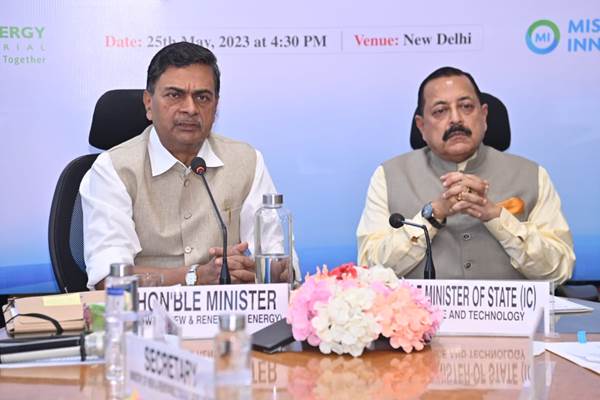
Science and Technology Minister Dr. Jitendra Singh said: “India is committed to a low carbon future and aims to transform the energy landscape of the country by accelerating clean energy innovation. We all have collective responsibility to work together for a more secure and sustainable future. The ever-growing challenges of climate change are beyond the control of one country, organization, company, or any individual effort.”
Clean Energy Ministerial
The Clean Energy Ministerial (CEM) was established in 2009 as a high-level global forum to promote policies and programmes that advance clean energy technology, to share lessons learned and best practices, and to encourage the transition to a global clean energy economy. Initiatives are based on areas of common interest among participating governments and other stakeholders. The Framework for the Clean Energy Ministerial, reaffirmed at the twelfth Clean Energy Ministerial in 2021, defines the CEM governance structure and outlines the mission statement, objectives, membership, and guiding principles. The CEM is an international clean energy leadership platform, a convening platform, an action platform, and an acceleration platform.
India hosted the 4th Clean Energy Ministerial (CEM-4) in 2013. Through its leadership of the CEM’s Global Lighting Challenge campaign, which was inspired by India’s Unnat Jyoti by Affordable LEDs for All (UJALA) program, India helped many other governments and industry partners to achieve a global collective target of 10 billion LEDs globally. This effort was coordinated by the Bureau of Energy Efficiency on behalf of the Government of India.
The CEM has 29 members: the European Commission and 28 governments (largely aligned with the G20 membership) namely Australia, Brazil, Canada, Chile, China, Denmark, Finland, France, Germany, India, Indonesia, Italy, Japan, Korea, Mexico, Netherlands, New Zealand, Norway, Poland, Portugal, Russia, Saudi Arabia, South Africa, Spain, Sweden, the United Arab Emirates, the United Kingdom and the United States.
Mission Innovation
Mission Innovation (MI) is a Ministerial-level global forum of 23 Countries and the European Commission (on behalf of the European Union) to accelerate Clean Energy revolution and progress towards the Paris Agreement goals and pathways to Net Zero. The main objective of MI is to catalyse a decade of action and investment in research, development and demonstration to make clean energy affordable, attractive and accessible for all. It does this by taking steps to accelerate clean energy innovation to mobilise low-cost finance by international partners, enhance private sector investments and demand for clean technologies that advances R&D of clean energy technology.
The first phase of Mission Innovation (MI) (2015-2020) was announced at COP21 on November 30, 2015, as world leaders came together in Paris to commit the ambitious efforts to combat climate change. As part of the launch statement, all the member countries committed to double Government funding on clean energy research, development and demonstration (RD&D) over 5 years and enhance international and private sector engagement, cooperation and investments in programmes on clean energy RD&D. After a successful 5 years’ stint of first phase and recognising the vital need for clean energy investment to accelerate innovation, the second phase of Mission Innovation (MI2.0) was launched on June 2, 2021. The focus of MI2.0 is on decade of action (2021-2030) and the emphasis is to scale-up the deployment of innovative clean energy technology and make clean energy affordable, attractive and accessible for all. This will accelerate progress towards the Paris Agreement goals and pathways to net zero.
Both CEM and MI aim to share lessons learned and best practices to facilitate the transition to a global clean energy economy. They do so through a combination of an Annual Ministerial meeting featuring plenaries, side-events and high-level roundtables, and year-round technical work in the form of initiatives and campaigns within CEM and missions within MI, that deliver collective actions.


